
I bought this cast iron skillet (Griswold small logo ~1940ish) off ebay for $20 because these old skillets are thinner, lighter and a hell of a lot more smooth than today's from Lodge, etc. but the cooking surface on this one had some sharp spots and issues from the previous owner seasoning it incorrectly so I decided to do a full restoration.
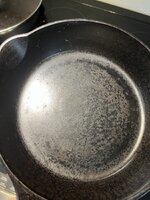
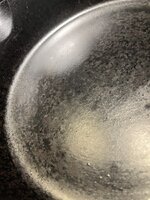
I want this to be my breakfast/egg pan so I needed to restore the perfect smooth cooking surface that these old Griswold’s are known for to get that slick non-stick effect. So I built my own electrolysis tank to strip the skillet down to the bare iron so I could then re-season it and make this 80yo skillet like new.
Electrolysis tank:
- 5gal bucket (this is a small skillet so a larger skillet may need a bigger container)
- Scrap steel bar (anything somewhat clean, just no stainless)
- Copper wire thick gauge
- Steel wire
- A piece of scrap lumber
- Washing soda (sodium carbonate)
- A 12v battery charger (older the better)
Here is a photo of my setup for a general idea.


My old battery charger struggled to give it the full amperage consistently and hovered around 2-4amps most of the time. I think this is why it ended up taking the better part of 24-36hrs in the tank to strip all the old residue off. After it was done in the tank, it took some elbow grease, steel wool, and some scrub pads to clean off every flake of residue that was stuck in any scratches or dimples.
At that point I had my bare iron pan and it was time to re-season it. If you’ve never seasoned cast iron before it’s a pretty simple process, just take a high temp fat or oil (I used a pre-mixed seasoning compound which consists of beeswax and grape seed oil), use a rag to wipe the oil all over the pan even the handle and bottom, you want the hole thing covered. Then use a clean rag to wipe away all the excess oil, this is a crucial step because if you leave too much oil on the pan you’ll get a lumpy and sharp seasoned surface which is what made me start this restoration in the first place. Then throw your BBQ grill on high and set the skillet in there for 20-30 min and you should have a layer of seasoning locked in. When seasoned properly the skillet should be smooth and feel polished, if there’s any sticky or oily spots at all keep it in the grill another 20 min or until the sticky spot is smooth to the touch. Repeat this process 4x for a solid foundational season and then your all set to use the pan! Additional seasoning via regular use always helps keep the skillet in good shape, but doing a full season every month or so never hurts. Below you can see the progression from bare iron to fully seasoned, that bronze color is a good indicator of a solid foundation on your cast iron.

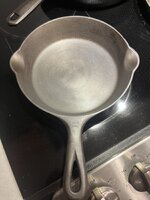
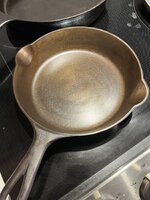
Final product is just as nonstick as my expensive coated pans. Here is my first attempt at a fried egg, over easy, no crust, just how my I like it.
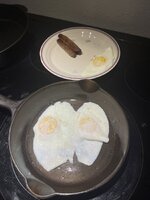
Has anyone else restored some cast iron with electrolysis? Or is there a better way you know of? I'm also curious to see if anyone has previous experience with electrolysis that can help improve and troubleshoot my system as I start to build a bigger tank for larger skillets?
Thanks for reading!
